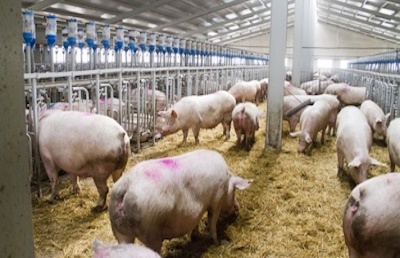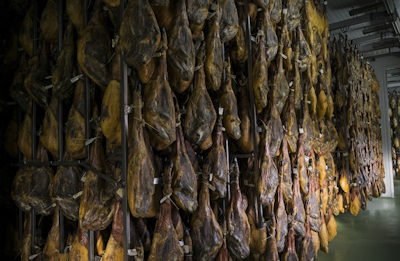The main and most notable difference is the external appearance, both the colour and the morphology, but there are many more aspects that differentiate them, including the type of breeding, feeding and organoleptic properties of the meat, even the maturation time that each leg of pork needs for the meat to be at its optimum point, it will be different if it is an Iberico ham or a Serrano ham.
Genetic differences between Iberian and white pigs
DNA is the main differentiating characteristic between the white pig and the Iberian pig. They come from different genetic stock, each with its own peculiarities.
White pig:
White pigs bred in Spain come from animals of European origin that have been crossed with other native breeds. The most commonly used by the meat industry are Landrace and Large white, as well as the Duroc breed, which has different characteristics to the other white breeds and is the only one that can be crossed with Iberian pigs to obtain Iberian percentages (50%-75% Iberian).
These are pig breeds that have been genetically selected by the industry, which is why today's breeds are quite different from the original ones.
Iberian Pigs:
As the name suggests, these are indigenous breeds from the Iberian Peninsula, Spain and Portugal.
The most striking difference is their skin colour, which is darker, even turning black depending on the breed.
They have not undergone any genetic modification by man, so they are exactly the same as the original specimens.
There are three varieties of Iberian pigs:
- Black varieties: Negro Lampiño (hairless) and Negro entrepelado.
- Coloured varieties: Retinto and Rubio andaluz.
- Manchado de Jabugo: Native breed of the Sierra de Aracena (Huelva) and registered as a breed in danger of extinction by the Ministry of Agriculture.
The most commonly used variety is the Retinta or Colorada which, in addition to being very prolific, allows a higher yield of Iberian ham legs.
Morphological differences between the white and Iberian pigs
Iberian pigs are smaller, their heads are not as prominent as those of white pigs and their snouts are elongated. Their legs are longer and more slender, with thin shanks. They are much more agile and adapted to life in the open air, being able to travel several kilometres throughout the day in search of food in the pastures.
Today's white pigs are created to give a high yield due to the great demand for their meat worldwide. It has a more robust body, a flat snout and wide limbs and is not adapted to life in the open air, among other reasons its pinkish skin layer would suffer from sunburn.
Breeding and feeding of white and Iberian pigs


The type of feeding and way of life is also very different in the two breeds. While the Iberian acorn-fed pig and the Iberian free-range pig are reared in the wild throughout their lives and have at their disposal the acorns and the natural resources of the countryside and the pasture, respectively, the white-skinned pig is reared intensively and fed exclusively on cereals.
Cebo Iberico ham, although it comes from Iberian breed pigs, has the same type of breeding and feeding as the white pig, which is why its price is much cheaper.
Organoleptic properties: aroma, flavour and texture
Properties of the Iberian pig:
Due to the particular property of the Iberian breeds to infiltrate the fat at intramuscular level, the meat has different characteristics.
Nutty nuances due to the consumption of acorns in both flavour and aroma if we refer to an Iberian acorn-fed ham. Although the Cebo de Campo Iberico ham does not feed on these fruits, its diet does include the wild pasture of the dehesa, which can also be appreciated in the properties of its meat.
It has a mellow texture due to the streaks of fat in the meat and a fairly pronounced intensity of flavour when compared to Serrano hams.
The Iberian Cebo ham, although it is fed only on cereals, has the same capacity to infiltrate the fat into the meat.
If you want more information about Iberian hams, click here.
Properties of the white pig:
Serrano ham, which is obtained from white pigs, has a milder flavour; its meat is leaner and its aroma is more subtle, without the infiltrated fat typical of the Iberian pig.
It goes without saying that there are many high quality Serrano hams, such as Trevélez ham, Teruel ham, Extremadura Serrano hams and hams from the Alpujarra or from the area of Granada and the Sierra de Baza.
The Duroc ham, although included in the white breeds, has some characteristics similar to the Iberian ham, even in its skin, which is darker, with a black hoof and the ability to infiltrate the fat into the meat, which is why it is the only breed authorised to crossbreed with the Iberian pig.
Curing times for a leg of white ham and a leg of Iberian ham

Precisely because of the intramuscular fat of the Iberian pig, the curing times of the hams are much longer. The white pig, having leaner meat, does not need so much time.
The minimum time established by law for an Iberian ham under 7 kg is 600 days, almost 20 months, and for Iberian hams over 7 kg, 700 days, 24 months.
These are the minimum times, but many hams exceed these times, depending on the type of product. For example, hams that are dried naturally, such as those you can buy in the Jamón Pasión shop, require a longer maturation time, as their time is not accelerated in artificial drying rooms and can reach 36 and 48 months.
A Serrano ham, depending on its category, has a minimum drying time of 9 months for a Bodega ham; 12 months for a Reserva ham and 15 months for a Gran Reserva ham.
Duroc hams exceed these times, needing a period of between 20 and 24 months due to their higher proportion of infiltrated fat.
